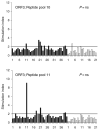T-cell epitope mapping of ORF2 and ORF3 proteins of human hepatitis E virus
- PMID: 17381721
- PMCID: PMC2441432
- DOI: 10.1111/j.1365-2893.2006.00796.x
T-cell epitope mapping of ORF2 and ORF3 proteins of human hepatitis E virus
Abstract
Little data are available on cellular immune responses during infection with hepatitis E virus (HEV). We therefore mapped CD4 T-cell epitopes in open reading frame (ORF)2 and ORF3 proteins of HEV using lymphocyte proliferation assays and overlapping peptide libraries. Proliferation of peripheral blood mononuclear cells from 40 patients with acute hepatitis E and 21 healthy controls with recombinant HEV ORF2 protein or pools of overlapping HEV ORF2/ORF3 peptides was measured. HLA-DQB1 and HLA-DRB1 alleles were also determined. Mononuclear cells from patients with hepatitis E more often showed significant proliferation on stimulation with recombinant ORF2 protein than controls (32/40 vs 7/21), and had higher median (range) stimulation indices [2.6 (0.9-15.2) vs 1.3 (0.6-12.9)]. Peptide pools corresponding to amino acids 73-156, 289-372, 361-444 and 505-588 of HEV ORF2 protein were associated with significant proliferation. Individual peptides in these pools did not show a clear pattern of stimulation. HEV ORF3 peptide pools did not induce proliferative responses. Lymphocyte proliferation in response to the peptide pool corresponding to amino acids 289-372 of HEV ORF2 protein was associated with presence of HLA-DRB1 allele 010X. These data on mapping of T-cell epitopes in HEV proteins may prove useful for designing HEV vaccines and for studying the immunopathogenesis of hepatitis E.
Figures




References
-
- Aggarwal R, Krawczynski K. Hepatitis E: an overview and recent advances in clinical and laboratory research. J Gastroenterol Hepatol. 2000;15:9–20. - PubMed
-
- Krawczynski K, Aggarwal R. Hepatitis E. In: Schiff ER, Sorrell MF, Maddrey WC, editors. Schiff’s Diseases of the Liver. 9th edn. Philadelphia, PA: Lippincott-Raven; 2002. pp. 877–889.
-
- Aggarwal R, Naik SR. Hepatitis E: intrafamilial transmission versus waterborne spread. J Hepatol. 1994;22:718–723. - PubMed
-
- Somani SK, Aggarwal R, Naik SR, Srivastava S, Naik S. A serological study of intra-familial spread from patients with sporadic hepatitis E virus infection. J Viral Hepat. 2003;10:446–449. - PubMed
Publication types
MeSH terms
Substances
Grants and funding
LinkOut - more resources
Full Text Sources
Research Materials

